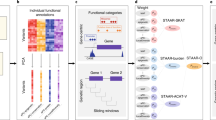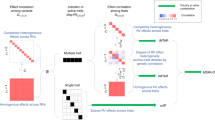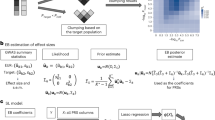Abstract
Using a genome-wide screen of 9.6 million genetic variants achieved through 1000 Genomes Project imputation in 62,166 samples, we identify association to lipid traits in 93 loci, including 79 previously identified loci with new lead SNPs and 10 new loci, 15 loci with a low-frequency lead SNP and 10 loci with a missense lead SNP, and 2 loci with an accumulation of rare variants. In six loci, SNPs with established function in lipid genetics (CELSR2, GCKR, LIPC and APOE) or candidate missense mutations with predicted damaging function (CD300LG and TM6SF2) explained the locus associations. The low-frequency variants increased the proportion of variance explained, particularly for low-density lipoprotein cholesterol and total cholesterol. Altogether, our results highlight the impact of low-frequency variants in complex traits and show that imputation offers a cost-effective alternative to resequencing.
This is a preview of subscription content, access via your institution
Access options
Subscribe to this journal
Receive 12 print issues and online access
$209.00 per year
only $17.42 per issue
Buy this article
- Purchase on Springer Link
- Instant access to full article PDF
Prices may be subject to local taxes which are calculated during checkout



Similar content being viewed by others
References
Gibson, G. Rare and common variants: twenty arguments. Nat. Rev. Genet. 13, 135–145 (2011).
Teslovich, T.M. et al. Biological, clinical and population relevance of 95 loci for blood lipids. Nature 466, 707–713 (2010).
Willer, C.J. et al. Discovery and refinement of loci associated with lipid levels. Nat. Genet. 45, 1274–1283 (2013).
1000 Genomes Project Consortium. An integrated map of genetic variation from 1,092 human genomes. Nature 491, 56–65 (2012).
Marchini, J., Howie, B., Myers, S., McVean, G. & Donnelly, P. A new multipoint method for genome-wide association studies by imputation of genotypes. Nat. Genet. 39, 906–913 (2007).
Howie, B.N., Donnelly, P. & Marchini, J. A flexible and accurate genotype imputation method for the next generation of genome-wide association studies. PLoS Genet. 5, e1000529 (2009).
Rall, S.C., Weisgraber, K.H., Innerarity, T.L. & Mahley, R.W. Identical structural and receptor binding defects in apolipoprotein E2 in hypo-, normo-, and hypercholesterolemic dysbetalipoproteinemia. J. Clin. Invest. 71, 1023–1031 (1983).
Rall, S.C., Weisgraber, K.H., Innerarity, T.L. & Mahley, R.W. Structural basis for receptor binding heterogeneity of apolipoprotein F from type III hyperlipoproteinemic subjects. Proc. Natl. Acad. Sci. USA 79, 4696–4700 (1982).
Cohen, J.C., Boerwinkle, E., Mosley, T.H. & Hobbs, H.H. Sequence variations in PCSK9, low LDL, and protection against coronary heart disease. N. Engl. J. Med. 354, 1264–1272 (2006).
Romeo, S. et al. Population-based resequencing of ANGPTL4 uncovers variations that reduce triglycerides and increase HDL. Nat. Genet. 39, 513–516 (2007).
Holmen, O.L. et al. Systematic evaluation of coding variation identifies a candidate causal variant in TM6SF2 influencing total cholesterol and myocardial infarction risk. Nat. Genet. 46, 345–351 (2014).
Kozlitina, J. et al. Exome-wide association study identifies a TM6SF2 variant that confers susceptibility to nonalcoholic fatty liver disease. Nat. Genet. 46, 352–356 (2014).
Dupuis, J. et al. New genetic loci implicated in fasting glucose homeostasis and their impact on type 2 diabetes risk. Nat. Genet. 42, 105–116 (2010).
Kahn, B.B., Alquier, T., Carling, D. & Hardie, D.G. AMP-activated protein kinase: ancient energy gauge provides clues to modern understanding of metabolism. Cell Metab. 1, 15–25 (2005).
Beer, N.L. et al. The P446L variant in GCKR associated with fasting plasma glucose and triglyceride levels exerts its effect through increased glucokinase activity in liver. Hum. Mol. Genet. 18, 4081–4088 (2009).
Weisgraber, K.H., Rall, S.C. & Mahley, R.W. Human E apoprotein heterogeneity. Cysteine-arginine interchanges in the amino acid sequence of the apo-E isoforms. J. Biol. Chem. 256, 9077–9083 (1981).
Ghebranious, N., Ivacic, L., Mallum, J. & Dokken, C. Detection of ApoE E2, E3 and E4 alleles using MALDI-TOF mass spectrometry and the homogeneous mass-extend technology. Nucleic Acids Res. 33, e149 (2005).
Deeb, S.S. & Peng, R. The C-514T polymorphism in the human hepatic lipase gene promoter diminishes its activity. J. Lipid Res. 41, 155–158 (2000).
Durstenfeld, A., Ben-Zeev, O., Reue, K., Stahnke, G. & Doolittle, M.H. Molecular characterization of human hepatic lipase deficiency. In vitro expression of two naturally occurring mutations. Arterioscler. Thromb. 14, 381–385 (1994).
Liu, D.J. et al. Meta-analysis of gene-level tests for rare variant association. Nat. Genet. 46, 200–204 (2014).
Albrechtsen, A. et al. Exome sequencing–driven discovery of coding polymorphisms associated with common metabolic phenotypes. Diabetologia 56, 298–310 (2013).
Takatsu, H. et al. CD300 antigen like family member G: a novel Ig receptor like protein exclusively expressed on capillary endothelium. Biochem. Biophys. Res. Commun. 348, 183–191 (2006).
Umemoto, E. et al. Nepmucin, a novel HEV sialomucin, mediates l-selectin–dependent lymphocyte rolling and promotes lymphocyte adhesion under flow. J. Exp. Med. 203, 1603–1614 (2006).
Jin, S. et al. Nepmucin/CLM-9, an Ig domain–containing sialomucin in vascular endothelial cells, promotes lymphocyte transendothelial migration in vitro. FEBS Lett. 582, 3018–3024 (2008).
Cannon, J.P., O'Driscoll, M. & Litman, G.W. Specific lipid recognition is a general feature of CD300 and TREM molecules. Immunogenetics 64, 39–47 (2012).
Carim-Todd, L., Escarceller, M., Estivill, X. & Sumoy, L. Cloning of the novel gene TM6SF1 reveals conservation of clusters of paralogous genes between human chromosomes 15q24→q26 and 19p13.3→p12. Cytogenet. Cell Genet. 90, 255–260 (2000).
Mahdessian, H. et al. TM6SF2 is a regulator of liver fat metabolism influencing triglyceride secretion and hepatic lipid droplet content. Proc. Natl. Acad. Sci. USA 111, 8913–8918 (2014).
Fehrmann, R.S. et al. Gene expression analysis identifies global gene dosage sensitivity in cancer. Nat. Genet. 47, 115–125 (2015).
Wood, A.R. et al. Defining the role of common variation in the genomic and biological architecture of adult human height. Nat. Genet. 46, 1173–1186 (2014).
van Dongen, J., Willemsen, G., Chen, W.M., de Geus, E.J. & Boomsma, D.I. Heritability of metabolic syndrome traits in a large population-based sample. J. Lipid Res. 54, 2914–2923 (2013).
Mägi, R. et al. Genome-wide association analysis of imputed rare variants: application to seven common complex diseases. Genet. Epidemiol. 36, 785–796 (2012).
Blattmann, P., Schubert, C., Pepperkok, R. & Runz, H. RNAi-based functional profiling of loci from blood lipid genome-wide association studies identifies genes with cholesterol-regulatory function. PLoS Genet. 9, e1003338 (2013).
Service, S.K. et al. Re-sequencing expands our understanding of the phenotypic impact of variants at GWAS loci. PLoS Genet. 10, e1004147 (2014).
Johansen, C.T. et al. Excess of rare variants in genes identified by genome-wide association study of hypertriglyceridemia. Nat. Genet. 42, 684–687 (2010).
Purcell, S. et al. PLINK: a tool set for whole-genome association and population-based linkage analyses. Am. J. Hum. Genet. 81, 559–575 (2007).
Mägi, R. & Morris, A.P. GWAMA: software for genome-wide association meta-analysis. BMC Bioinformatics 11, 288 (2010).
Mägi, R., Lindgren, C.M. & Morris, A.P. Meta-analysis of sex-specific genome-wide association studies. Genet. Epidemiol. 34, 846–853 (2010).
Choi, Y., Sims, G.E., Murphy, S., Miller, J.R. & Chan, A.P. Predicting the functional effect of amino acid substitutions and indels. PLoS ONE 7, e46688 (2012).
Ng, P.C. & Henikoff, S. Predicting deleterious amino acid substitutions. Genome Res. 11, 863–874 (2001).
Adzhubei, I.A. et al. A method and server for predicting damaging missense mutations. Nat. Methods 7, 248–249 (2010).
Cvejic, A. et al. SMIM1 underlies the Vel blood group and influences red blood cell traits. Nat. Genet. 45, 542–545 (2013).
Yang, J., Lee, S.H., Goddard, M.E. & Visscher, P.M. GCTA: a tool for genome-wide complex trait analysis. Am. J. Hum. Genet. 88, 76–82 (2011).
Acknowledgements
We acknowledge CSC (IT Center for Science) and the Technology Centre of the Institute for Molecular Medicine for computational services. The High-Throughput Biomedicine Unit of the Institute for Molecular Medicine Finland, R. Kovanen and A. Uro are acknowledged for technical expertise. M. Jauhiainen is acknowledged for sharing his expertise in the manuscript writing process. This research was supported through funds from the European Union's Seventh Framework Programme (FP7/2007–2013), ENGAGE Consortium, grant agreement HEALTH-F4-2007-201413. I.S. was partly funded by the Helsinki University Doctoral Programme in Biomedicine (DPBM). M.H. was funded by a Manpei Suzuki Diabetes Foundation Grant-in-Aid for young scientists working abroad. A.P.M. and A. Mahajan acknowledge funding from the Wellcome Trust under awards WT098017, WT090532 and WT064890. V. Lagou, L.M., S.H. and I.P. were funded in part through the European Union's Seventh Framework Programme (FP7/2007–2013), ENGAGE project, grant agreement HEALTH-F4-2007- 201413. L.M. was in part sponsored by '5 per mille' contribution assigned to the University of Ferrara, income tax return year 2009, and in part by the ENGAGE Exchange and Mobility Program for ENGAGE training funds. M.D.T. holds a UK Medical Research Council Senior Clinical Fellowship (G0902313). S.T. is supported by the Sigrid Juselius Foundation. J.S.R. and C.G. have received funding from a grant from the RFBR (Russian Foundation for Basic Research)–Helmholtz Joint Research Group (12-04-91322). C.G. received funding from the European Union's Seventh Framework Programme (FP7-Health-F5-2012) under grant agreement 305280 (MIMOmics). M. Perola has been supported by the European Union's Seventh Framework Programme (grant agreements 313010; BBMRI-LPC, 305280; MIMOmics, and 261433; BioSHaRE-EU), Finnish Academy grant 269517, the Yrjö Jahnsson Foundation and the Juho Vainio Foundation. N.J.S. holds a chair funded by the British Heart Foundation (BHF) and is an NIHR Senior Investigator. C.P.N. is funded by the BHF and was preciously funded by the NIHR Leicester Cardiovascular Biomedical Research Unit. V. Salomaa was supported by the Finnish Foundation for Cardiovascular Research and the Finnish Academy (grant 139635). E. Ikonen was supported by the Academy of Finland Centre of Excellence in Biomembrane Research (272130), the Academy of Finland (263841) and the Sigrid Juselius Foundation. V.P. was supported by a University of Helsinki Postdoctoral Researcher grant, the Magnus Ehrnrooth Foundation and the Kymenlaakso Cultural Foundation. O.K., J.-P.M. and V.P. have received funding from the European Union's Seventh Framework Programme (FP7/2007–2013) under grant agreement 258068; EU-FP7-Systems Microscopy Network of Excellence. S.R. was supported by the Academy of Finland (251217 and 255847), the Center of Excellence in Complex Disease Genetics, the European Union's Seventh Framework Programme projects ENGAGE (201413) and BioSHaRE (261433), the Finnish Foundation for Cardiovascular Research, Biocentrum Helsinki and the Sigrid Juselius Foundation. Cohort-specific acknowledgments are provided in the Supplementary Note.
Author information
Authors and Affiliations
Consortia
Contributions
I.S., M.H., R.M., A.-P.S., A. Mahajan, V. Lagou, L.M., T.F., E. Ikonen, O.K., V.P., C.M.L., U.T., A. Palotie, M.I.M., A.P.M., I.P. and S.R. designed and performed experiments, analyzed data and wrote the manuscript. B.M., S.T., J. Kettunen, M. Pirinen, J. Karjalainen, H.-J.W., J.-P.M., T.H.P. and L.F. performed follow-up experiments and analyzed the data. G.T., S.H., J.-J.H., A.I., C.L., M. Beekman, T.E., J.S.R., C.P.N., C.W. and S.G. analyzed cohort-specific data. H.S., J.E., N.J.S., J. Kaprio, L.L., C.G., A. Metspalu, P.E.S., L.G., C.M.v.D., J.G.E., A.J., V. Salomaa, D.I.B., C.P., O.T.R., E. Ingelsson, M.-R.J. and K.S. designed cohort-specific experiments. M. Blades, A.J.M.d.C., E.J.d.G., J.D., H.G., A.H., A.S.H., C.H., J.J.H.-D., E.H., L.C.K., T.L., V. Lyssenko, P.K.E.M., E.M., M.M.-N., N.L.P., B.W.J.H.P., M. Perola, A. Peters, J.R., J.H.S., V. Steinthorsdottir, M.D.T., N.T., E.M.v.L., J.S.V., S.M.W. and G.W. performed cohort-specific experiments and analyzed cohort-specific data. All authors contributed to the research and reviewed the manuscript.
Corresponding author
Ethics declarations
Competing interests
U.T., G.T., V. Steinthorsdottir and K.S. are employed by deCODE Genetics/Amgen, Inc.
Supplementary information
Supplementary Text and Figures
Supplementary Figures 1–8, Supplementary Tables 1–8 and 10–15, and Supplementary Note. (PDF 14648 kb)
Supplementary Table 9
Lists of genes with higher MGI-based predictions in the GeneNetwork database for the knockout phenotypes listed in Supplementary Table 8a,b. (XLSX 207 kb)
Rights and permissions
About this article
Cite this article
Surakka, I., Horikoshi, M., Mägi, R. et al. The impact of low-frequency and rare variants on lipid levels. Nat Genet 47, 589–597 (2015). https://doi.org/10.1038/ng.3300
Received:
Accepted:
Published:
Issue Date:
DOI: https://doi.org/10.1038/ng.3300
This article is cited by
-
Uncovering the complex genetic architecture of human plasma lipidome using machine learning methods
Scientific Reports (2023)
-
Genome-wide association analysis of plasma lipidome identifies 495 genetic associations
Nature Communications (2023)
-
Genome-wide association study of varicose veins identifies a protective missense variant in GJD3 enriched in the Finnish population
Communications Biology (2023)
-
Identification of genomic-wide genetic links between cutaneous melanoma and obesity-related physical traits via cFDR
Genes & Genomics (2023)
-
An adaptive test based on principal components for detecting multiple phenotype associations using GWAS summary data
Genetica (2023)



